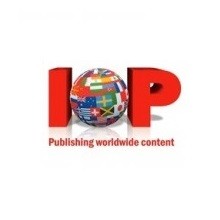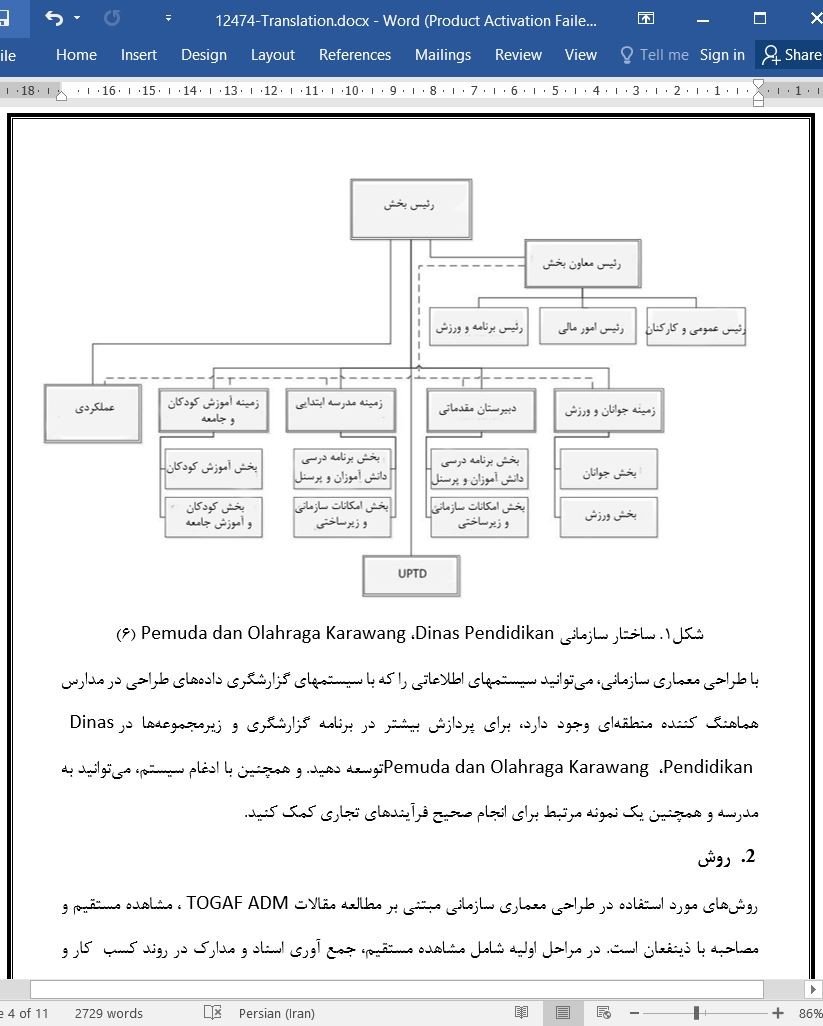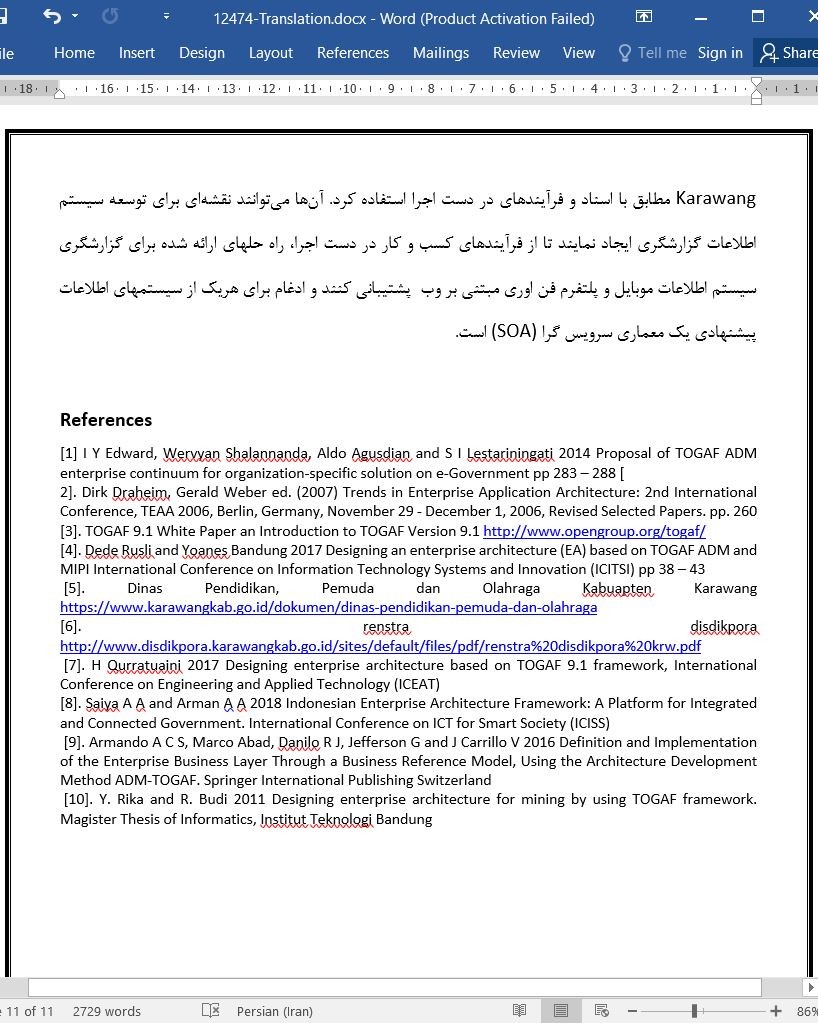
دانلود مقاله طراحی معماری سازمانی با استفاده از روش توسعه معماری توگف (TOGAF)
چکیده
هدف از این تحقیق، توسعه سیستم اطلاعاتی موجود با طراحی سیستم گزارشگری اطلاعات مدارس از هماهنگ کننده منطقهای به منظور پردازش بیشتر آن در زیرمجموعهای از برنامهها و گزارشگری در دفتر آموزش، جوانان و ورزش اداره نايب السلطنه Karawang میباشد (Dinas Pendidikan، Pemuda Dan Olahraga Karawang). روش مورد استفاده برای طراحی معماری سازمانی، چارچوب آزاد معماری گروهی روش توسعه معماری توگف (TOGAF ADM) است. مراحل اعمال شده در این طراحی عبارتند از TOGAF ADM ، آماده سازی، چشم انداز معماری، چشم انداز تجاری، معماری سیستم اطلاعات و معماری فن آوری. این تحقیق طرحی را ارائه میدهد که برای پشتیبانی از فرآیندهای تجاری در دست اجرا مورد استفاده قرار میگیرد. خروجی این مرحله، یک معماری سازمانی را ایجاد میکند که بعداً میتواند توسط سازمانها برای پشتیبانی از فرایندهای تجاری و دستیابی به اهداف استراتژیک مورد استفاده قرار گیرد. این مطالعه نتیجه گیری میکند که استفاده از روش TOGAFADM به عنوان یک ابزار مورد استفاده در طراحی این معماری سازمانی سیستم اطلاعات بطور کلی میتواند مدلهای معماری طراحی را ایجاد کند که در راستای بینش و رسالت سازمان باشد و در سازمانهای دیگری که از نظر فرآیندهای تجاری شباهتهایی دارند، قابل استفاده باشد. این تحقیق، راه حلی را برای مشکل مفقود شدن و خلل در دادهها در طی فرآیند گزارشگری در قالب این کتابچه راهنمای کاربر ارائه میدهد.
1. مقدمه
برای طراحی یک طرح جامع دولت الکترونیک، خوب است که چارچوب مناسبی را انتخاب کنیم که بتواند دارای دستورالعمل و شاید روش یا حتی ابزار باشد. TOGAF یکی از جالبترین چارچوبهای موجود است و دارای یک دیدگاه بسیار غنی برای طراحی سیستمهای آن برای شرکتها میباشد (1). چارچوب آزاد معماری گروهی (TOGAF) چارچوبی برای معماری سازمانی است که رویکردی را برای طراحی، برنامه ریزی، اجرا و مدیریت معماری فن آوری اطلاعات سازمانی ارائه میدهد (2). چارچوب معماری TOGAF همانند این است. ویژگیهای معماری استاندارد ANSI/IEEE 1471-2000 سیستمهای مبتنی بر نرم افزار ممکن است به شرح زیر باشد: "تشکیلات اصلی سیستمی که اجزای آن را در بر دارد، روابط آنها با یکدیگر و محیط و اصول حاکم بر طراحی و تکامل آن (1). با این حال TOGAF دیدگاه مختص به خود را دارد که میتوان آن را به عنوان توصیف رسمی از یک "نظام حقوقی" یا برنامه دقیقی از آن در سطح اجزاء برای راهنمایی اجرای آن یا به عنوان" مؤلفههای ساختار ، رابطه معکوس و اصول و دستورالعملهای حاکم بر طراحی و تکامل آنها در طی زمان" تعریف کرد(1).
4. نتیجه گیری
نتیجهای که از اجرای TOGAF ADM در زیر مجموعه برنامهها و گزارشگری در Dinas Pendidikan ، Pemuda dan Olahraga Karawang میتوان گرفت این است که میتوان از فرایند طراحی معماری سازمانی با استفاده از TOGAF ADM در زیر مجموعه برنامه و گزارشگری در Dinas Pendidikan ، Pemuda dan Olahraga Karawang مطابق با اسناد و فرآیندهای در دست اجرا استفاده کرد. آنها میتوانند نقشهای برای توسعه سیستم اطلاعات گزارشگری ایجاد نمایند تا از فرآیندهای کسب و کار در دست اجرا، راه حلهای ارائه شده برای گزارشگری سیستم اطلاعات موبایل و پلتفرم فن اوری مبتنی بر وب پشتیبانی کنند و ادغام برای هریک از سیستمهای اطلاعات پیشنهادی یک معماری سرویس گرا (SOA) است.
Abstract
The purpose of this research is to developing an existing information system by designing a school data reporting system from the regional coordinator for further processing in the Sub Division of Programs and Reporting at Office of Education, Youth, and Sports of Karawang Regency (Dinas Pendidikan, Pemuda Dan Olahraga Karawang). The method used for designing Enterprise Architecture is the open group architecture framework Architecture Development Method (TOGAF ADM). The steps applied in this design are TOGAF ADM, among other Preparation, Architectural Vision, Business Architecture, Information System Architecture, and Technology Architecture. This research produces a blueprint that will be used to support informed business processes. The output of this stage will produce an enterprise architecture that can later be used by organizations to support business processes and achieve their strategic goals. This study concludes that using the TOGAFADM methodology as a tool used in designing this information system enterprise architecture can produce a design architectural models in general that are in accordance with the organization's vision and mission and can be applied in other organizations that have similarities in business processes. The impact of this research is a solution to the problem of data loss and damage during the reporting process in the form of manual.
1. Introduction
For designing the E-Government master plan is good, we must choose a good framework that can have guidelines, perhaps the method, or even tools. TOGAF is one of the most interesting frameworks that exist and have a point of view which is very rich for designing its systems for companies [1]. The open Group Architecture Framework (TOGAF) is a framework for enterprise architecture, which provides an approach to design, plan, implement, and manage enterprise information technology architecture [2]. TOGAF architecture framework is like that. Architectural specification ANSI/IEEE 1471-2000 standard (softwareintensive systems) may be stated as: "the basic organization of a system, embodied in its components, their relationships to each other and the environment, and the principles that govern it design and evolution [1]. However TOGAF has its own view, which can be defined as a formal description of a "legal system, or a detailed plan of the system at component level to guide its implementation, or as" "structure components, the reverse correlation, and the principles and guidelines governing their design and evolution over time. " [1].
4. Conclusion
The conclusion of the implementation of the TOGAF ADM in the Sub Division of Program and Reporting at Dinas Pendidikan, Pemuda dan Olahraga Karawang, a conclusion can be reached that is, the process of designing enterprise architecture using the TOGAF ADM can be used in a Sub Division of Program and Reporting at Dinas Pendidikan, Pemuda dan Olahraga Karawang in accordance with documents and processes that are currently running and able to produce a blueprint for making the reporting information system so that they can support business processes ongoing, solutions offered for reporting information system mobile and web-based technology platform and integration for each proposed information system is a Service Oriented Architecture (SOA).
چکیده
1. مقدمه
2. روش
3. نتایج و بحث
3.1. مرحله مقدماتی
3.2 چشم انداز معماری
3.3 معماری کسب و کار
3.4 معماری سیستم اطلاعات
3.4.1 معماری کاربردی
3.4.2 معماری دادهها
3.5 مرحله معماری فن آوری
4 نتیجه گیری
منابع
Abstract
1. Introduction
2. Method
3. Results and Discussion
3.1. Preliminary phase
3.2. Architecture vision
3.3. Business Architecture
3.4. Information System Architecture
3.4.1. Application Architecture
3.4.2. Data Architecture
3.5. Technology Architecture Phase
4. Conclusion
References
- اصل مقاله انگلیسی با فرمت ورد (word) با قابلیت ویرایش
- ترجمه فارسی مقاله با فرمت ورد (word) با قابلیت ویرایش، بدون آرم سایت ای ترجمه
- ترجمه فارسی مقاله با فرمت pdf، بدون آرم سایت ای ترجمه



